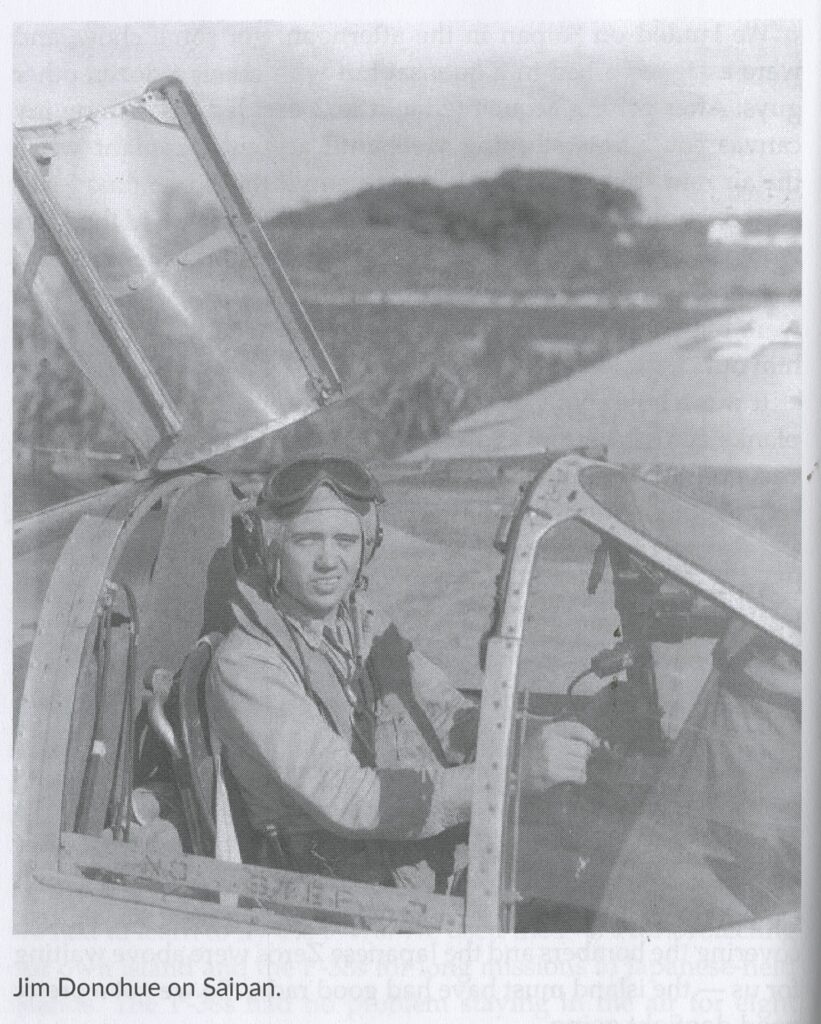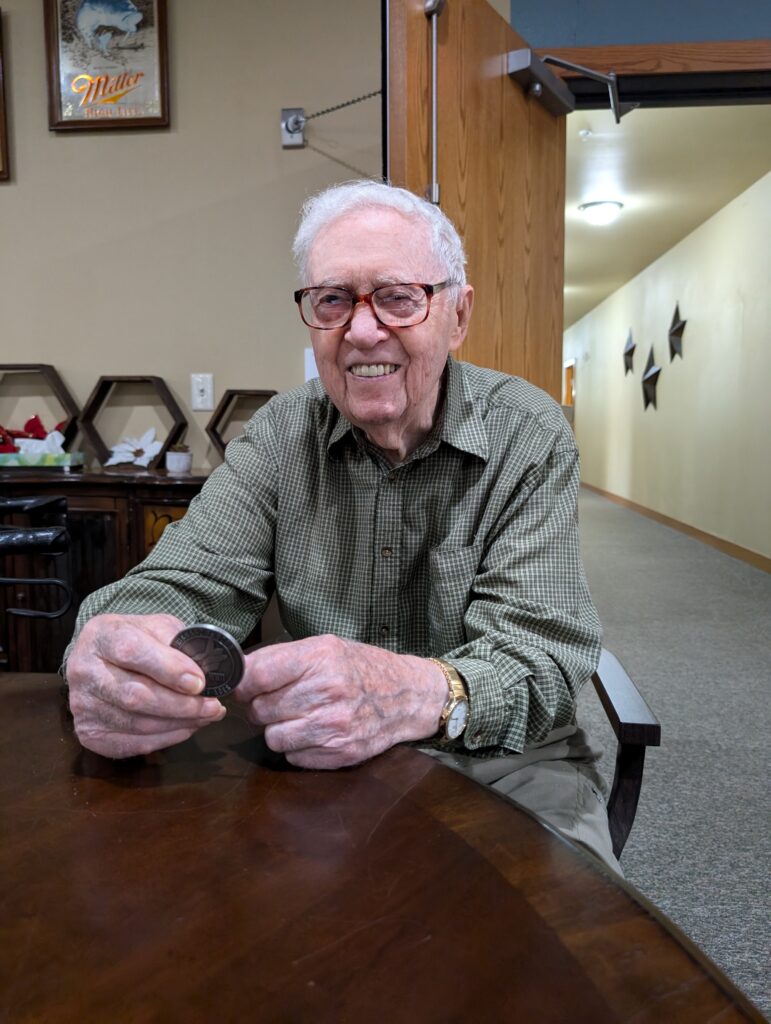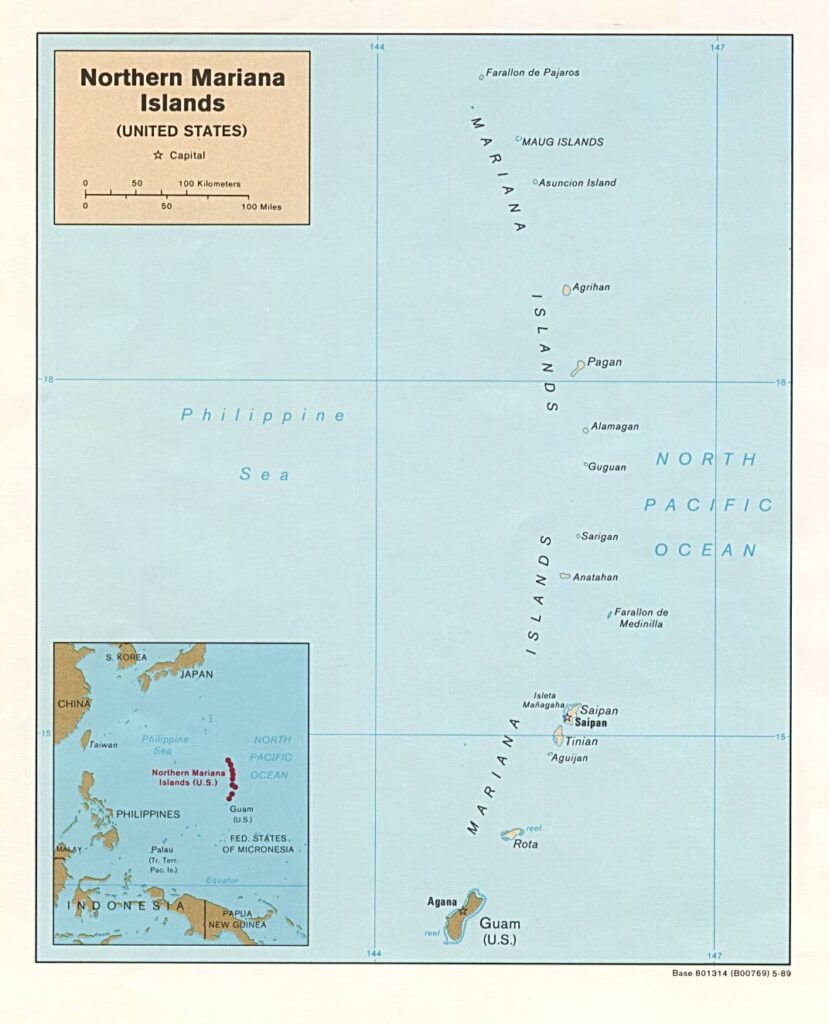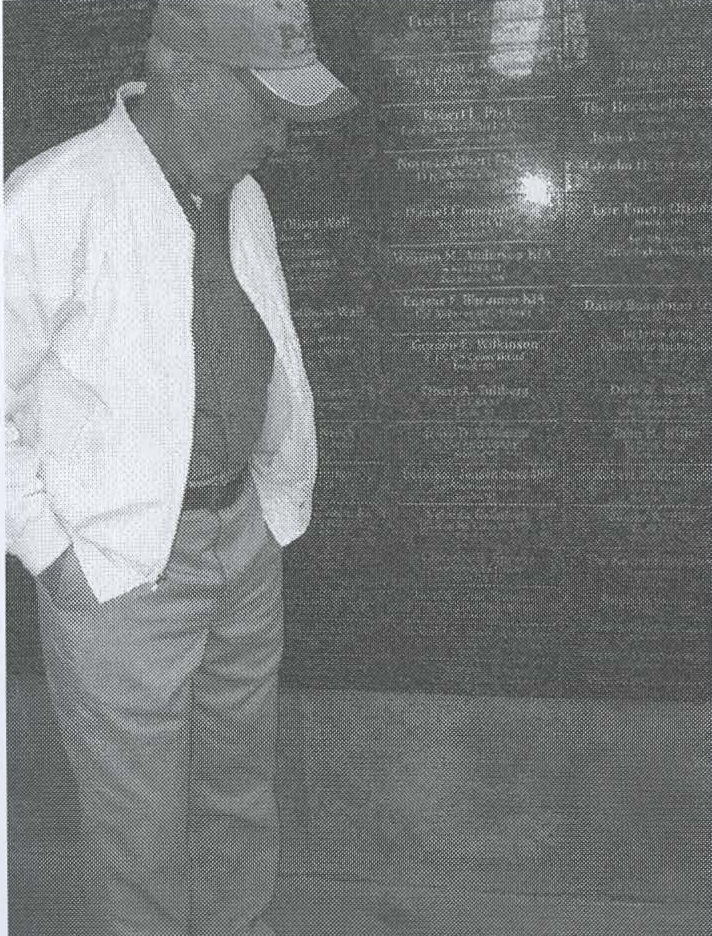

A Wisconsin Boyhood
Although you would never know it by looking at him, Jim Donohue turned 102 years old on Christmas Day 2024. He was born in Oxbo, Wisconsin in 1922. After graduating high school in 1941 he went to work in a logging camp in Michigan. It was while he was working there that he heard about the attack on Pearl Harbor. Filled with patriotism and a sense of responsibility, he decided to enlist into the Army Air Corps because he wanted to be a pilot.
A Pilot’s Determination
Without a two year college degree, Jim was not eligible for pilot’s training and went into a repair squadron. Then the Army dropped that requirement in lieu of passing a test. His high school education didn’t teach him the advanced math needed to pass the test the first time around, but Jim was determined to be a pilot. From his Alaska post, he studied and worked hard. Six months later, he took the test again and passed. He was able to leave the -73 degree weather at Ladd Field (outside Fairbanks) and head to sunny Santa Ana, California.
“The next eleven months were about the toughest I had ever gone through in my young life. I knew I would have to buckle down because I didn’t want to wash out. Less than 50% of the cadets who started the program made it to graduation.” said Jim about the training.
The hard work paid off and he made it through training. Assigned to Bellows Field in Hawaii with the 318th Fighter Group, 19th Fighter Squadron, he joined a fighter squadron flying the P-39 and learned fighter tactics and formation flying.
Most Memorable Day
When asked what his most memorable day was in the service, Jim didn’t need any time to think about it. In Hawaii, part of their training was in air-to-air gunnery practice. The target was placed on the runway with a long cable attaching it to the plane. The plane would take off and jerk it into the air. One plane will tow a target, while the others practiced firing at it. On the day it was Jim’s turn with the target, he almost went into the ocean. Usually on take off they use half throttle, but when towing a heavy target behind them, they need to use full throttle. No one told Jim. He didn’t have enough altitude to clear a barbed wire barrier at the end of the runway and the target got caught in the barbed wire, snapping the cable. It slowed him down so much the plane stalled. Jim’s training and confidence kicked in.
“The one thing you could never do was panic. You don’t have time to think, right? You’ve got to think and act at the same time. But if you panic, then you can’t think. That saved me a few times.” recalled Jim.
Jim reacted quickly, putting the nose down, giving it full throttle and he leveled out right above the waves.
In August 1944, the squadron received the P-38 Lightning, which would go on to become Jim’s favorite plane to fly. Now they were in serious combat training.
Into the Fight
In November 1944, Jim was sent over to the Pacific Theater, as part of the 19th Fighter Squadron based on Saipan, in the Mariana Islands. They were taking the P-38’s over to replace the P-47’s the 19th FS was currently using. They needed a fighter with a longer range, and the P-38 could handle the 700-800 range needed for combat fighting.

The Mariana Islands Campaign: May-November 1944
When Jim arrived in Saipan at the end of 1944, he was arriving on territory that had been hard fought for by the Allies. Saipan is part of the Mariana Islands, located approximately 1400 miles from the Japanese mainland.
The Japanese had administered the islands since 1914 and they captured Guam from the U.S. at the beginning of the war in 1941. On Saipan, the Japanese had built extensive infrastructure in the first half of the century. It was a significant base for the Japanese military as they moved through the Pacific, sending out reinforcements to battle areas and acting as a safe zone for retreating forces.
Due to its proximity to the Japanese mainland, the recapture of this territory was a top priority to the Allies. The plan was to put the B-29, a heavy bomber, on Saipan, putting it in range to make the trip to Japan.
On June 15, 1944, the invasion of Saipan began. Over 70,000 Marines, soldiers, and sailors would spend the next month in jungle combat and air warfare before securing the island in July. It wasn’t until mid-August that Tinian and Guam were also retaken and the Mariana Islands were in Allied hands. Seabee construction battalions were sent in and they quickly established airfields that could accommodate the enormous B-29 bomber. In less than two months, the expansions were complete and in mid-October the first B-29 bomber landed in the Islands. On November 24th, 1944 the first B-29 raid on Japan was sent out from Saipan. It was the beginning of the Allies ability to send massive forces to the Japanese homeland.
Meanwhile, the Japanese were trying to disrupt this bombing of Japan by the B-29’s. Jim and his fellow pilots spent their first two months in the Pacific Theater, from November 1944-January 1945, helping to counter these Japanese air attacks on the Mariana Islands.
It was not unusual for Jim and his fellow pilots to take off on 8-9 hour missions to Japanese held islands, routinely flying missions to Truk and Iwo Jima from Saipan – a 1500 mile, 8 hour trip. During these long missions, they were not able to get up and move around, they were sitting on their parachute and inflatable life raft and wearing a .45 pistol, sheath knife and life vest. Despite the drawbacks of piloting single seat fighter, the P-38 was Jim’s favorite plane.
There are no great pilots without great wingmen and Jim was proving to be talented at formation flying and was a formidable wingman.
“We had to stick together for protection. I was a wingman and could stay with the leader no matter what he did – loops, rolls, landings, and takeoffs – all in formation, sometimes four planes, sometimes two.” said Jim
In one mission, Jim was the wingman for the squadron commander, Lt. Col Williams. They got into a dogfight with a Japanese Zero and Jim watched his tracer go into the cockpit of the plane, and saw the plane flip over and go down in flames. P-38’s had gun camera footage that usually started recording as soon as the pilot started firing. After this mission, they found that Jim’s footage recorded, but Lt. Col WIlliams’ did not. Unfortunately, Jim didn’t get credit for shooting down this plane because the Lt. Col claimed credit.
“He said that my pictures were proof of his kill!” remembered Jim
Dogfights and Danger
In February 1945, his squadron made a fighter sweep over Iwo Jima. Before he left, his crew chief asked if he could put a picture of his wife in the plane so that he could write to her and tell her that her picture was on a mission over Iwo Jima. Jim readily agreed.
On the way over, he had engine trouble and was falling behind the other fighters. The flight leader told him not to continue but to go meet up with a bomber formation and stay with them. He climbed to a higher altitude and at the same time that he spotted the Allied bombers, he saw a Zero take off and head toward the formation. The Zero didn’t spot Jim’s lone P-38 flying so much higher above him. Jim took off in pursuit of the Japanese fighter. He cut off the Zero pilot’s two attempts to get away and hit him with a long burst of fire. The plane was on fire, and Jim watched as the Zero spiraled down and hit the water.
“The adrenaline was pumping so hard, I think it was coming out of my pores. I wasn’t scared because I knew what to do and how to do it. That’s where good training comes in.” said Jim.
When Jim returned to base, his crew chief was thrilled to hear that his wife’s picture not only accompanied a mission, but witnessed a kill.
When Jim started suffering some health problems in the spring of 1945, he was transferred back to a Hawaii hospital. He would never return to his squadron in the Pacific Theater and was eventually discharged in December 1945. He made his way back home and had a wonderful reunion with his parents.
New Beginnings: Family, Flying, and Reflection
Post-war, he met and married his wife Phyllis and started a family. They moved to Milwaukee, and had two daughters. In 1955, the desire to fly hadn’t left him and he joined the Air Force Reserves. For several years he flew American jets, F-80’s and T-33’s.
Reflecting on his military experience, Jim said, “They throw the word “hero” around pretty loosely these days. There’s no doubt there were some real heroes, but I never considered myself one. I had to do something so I picked out the best thing I could think of. I turned out to be pretty good at it, and I had fun”
Our time with the greatest generation is rapidly coming to a close. The men and women who fought overseas, who served at home, and those who worked in industry to produce the desperately needed materials leave a legacy that is unmatched and will never be repeated.
******************************************************************************************************************************
In his retirement, Jim wrote a book about his experiences in WWII. That book, Pea Shooter Pilot, was recently re-released on Amazon to include some of his poetry that he has written. He and his family gave us permission to post one of those poems as part of this article.
The Old Fighter Pilot Says
Getting old is like an airplane that isn’t hitting on all its cylinders and is nearly out of gas. You can’t gain any altitude, and you can’t loop and spin like you used to.
The old battle scars start to give you trouble, but you give it a little more throttle and you keep going.
You go back to the hanger for a tune up and the mechanics put in a few parts – you’re good to go again.
You take off and go as fast and as high as you can, because you know that someday you will go off into the wild blue yonder and not return.
But that’s the way it is.

Sources:
- Donohue, John Robert “Jim. Pea Shooter Pilot. Park Falls, Wisconsin, Self-published, 2024.
- Donohue, John Robert “Jim” . Oral History with Jim Donohue. 20 Dec. 2024.
- Kenney, George C. General Kenney Reports: A Personal History of the Pacific War. Air Force History and Museums Program, 1997.